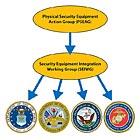
Figure 1. Organizational Relationships
The bombing of the United States Air Force housing area in the Khobar Towers in Saudi Arabia, the ramming of the U.S.S Cole in Yemen and the attack on the Pentagon using a hijacked plane are tragic reminders of the threats the U.S. military faces each day.
To combat possible future attacks, the Department of Defense (DoD) is increasing security measures and developing innovative anti-terrorism/force protection (AT/FP) equipment. However, the continued attacks against military installations in Iraq demonstrate that terrorists and insurgents still pose a significant threat to our armed services. How useful are military technological advances if they cannot be adequately secured and protected? How safe is our military without this protection? The answers emphasize the critical need for extensive physical security measures within the Department of Defense.
PROTECTING PHYSICAL ASSETS
How can the government better protect its military assets? That is the question that the Physical Security Equipment Action Group (PSEAG) and the Security Equipment Information Working Group (SEIWG) seek to answer.The PSEAG is the central manager for all Physical Security Equipment (PSE) Research, Development, Test and Evaluation (RDT&E) within the Department of Defense. The SEIWG is a standing subcommittee of the PSEAG as shown in Figure 1. These groups have been in the forefront of the military security world for close to 20 years. The SEIWG’s mission is to coordinate and influence system architecture, technical design and systems integration of all physical security equipment to be used within the DoD. In support of this DoD wide effort, the SEIWG has a multi-service membership that includes the U.S. Air Force, Army, Navy and Marine Corps.
The SEIWG chairperson designation rotates among the four services approximately every two years. Currently the position of SEIWG chairperson is held by the U.S. Air Force, specifically by Roy Higgins of the 642d Electronic Systems Squadron at Hanscom Air Force Base in Bedford, Mass.
The U.S. Air Force Electronic Systems Center 642d Electronic Systems Squadron (642 ELSS, formerly the Force Protection Systems Squadron) at Hanscom Air Force Base is supporting the SEIWG in developing a joint PSE technical architecture for application to all DoD PSE design and acquisition efforts. As shown in Figure 2, the architecture consists of three “views,” the Operational View, the Systems View and the Technical View. The Operational View depicts and describes the operational requirements with the elements, tasks and activities involved in meeting those requirements, as well as information flows required to accomplish operational mission requirements. The Systems View describes and interrelates the existing or postulated system designs, technologies, equipment and other resources intended to support the operational requirements. The Technical View describes the profile of rules, standards and conventions governing systems implementation.
In developing a joint PSE architecture embraced by all of the armed services, the SEIWG’s primary goal envisions security systems with shortened and less costly acquisition and development phases, minimized duplication, increased service interoperability and interchangeability and easier maintenance. The joint architecture will ensure future DoD security systems, for all four military services, integrate with existing systems and with each other and minimize the need for physical redesign. This translates to increased protection against international and domestic threats at lower costs and in reduced timeframes.

Figure 2. Joint Physical Security Equipment Architecture
OPERATIONS, SYSTEMS AND TECH
The SEIWG is accomplishing this far-reaching goal through work across all three of the architectural views. Over the past several years, the SEIWG has focused on the Technical View through the development of the Joint Anti-Terrorism/Force Protection Technical Standards Profile (TV-1) and Interface Control Documents (ICDs) for AT/FP equipment. These Technical View products will be used by all four services during the acquisition and development of future PSE.The TV-1 document, currently being prepared under contract to the U.S. AF, is a compilation of standards relating to AT/FP equipment. The document provides a focused profile of standards and protocols currently used by all the services in the development and procurement of physical security systems, equipment, and components for use in the 2007/2008 timeframe. The purpose of the document is to provide a program manager with a resource for identifying current AT/FP applicable standards. To aid a program manager with assessing the relevancy of an AT/FP standard, this document provides a brief synopsis of each standard, identifies the relevant areas to which the standard applies, identifies related or companion standards and provides hyperlinks to the standard or source of the standard. The standards are organized loosely into relevant categories including, but not limited to, Common Infrastructure, Communication, Command, Control, and Display Equipment, Access Control, Detection, Surveillance, Delay Denial Response and Power. To avoid presenting a biased position and possibly influencing system developers and architecture users toward a particular commercial solution, the TV-1 product focuses only on AT/FP related technologies and the standards that support them. The document does not contain any discussion of commercial products that implement the standards. Adherence to the standards presented in the TV-1 document will promote interoperability and commonality at every level of force protection.
Although the TV-1 document is not expected to be formally released until this summer it can be obtained via a request through the SEIWG chairperson Roy Higgins.
Periodically the TV-1 document will be reviewed, updated and reissued as deemed necessary by the SEIWG. Prior to each issuance the standards in the TV-1 document will be reviewed against the following criteria:
- Applicable to equipment and systems relevant to Anti-Terrorism/Force Protection
- Viable relative to industry trends and technology evolutionary directions
- Mature and used by at least three vendors in their product offerings
- Provide one or more required components relative to the needs defined in Operational Views and Systems Views
- Compatible with the overall set of technology being selected (integrates well with other technology standards being selected)
- Support the directions of the DoD: Net-Centric, Service Oriented, Component based, and use of the Global Information Grid
- Not proprietary

The physical security team: standing from left, Timothy Bootle, U.S. Marines; Edward Layo, U.S. Navy; Richard Goehring, U.S. Army; and (seated) Roy Higgins, U.S. Air Force.
XML CONNECTION
The TV-1 effort is just one way that the SEIWG is working to develop a joint PSE technical architecture. The SEIWG is also focusing on generating Interface Control Documents to standardize the communication interface between AT/FP systems using the eXtensible Markup Language (XML) 1.0, as defined by the World Wide Web Consortium. Recently the SEIWG published the SEIWG ICD-0100 document, which defines the structure and sequencing of information for communication between systems using XML. This ICD is broad enough to be applied to a variety of system types.The SEIWG is also currently developing two specific ICDs. The first ICD describes the communication between a centrally located system known as the Command, Control and Display Equipment (CCDE) that is used to monitor security alarms and the security situation in a base defense system and the devices originating the alarms or other information. This ICD consists of a series of sub-ICDs, or tabs, that standardize the XML schemas between the CCDE and AT/FP sensor equipment components. The ICD focuses on the communication interface between the CCDE and the detection, surveillance/assessment, access control, delay/denial, mass notification, and response devices including remotely operated weapons.
In addition to standardizing the communication in the hierarchal relationship between the CCDE and sensors, the SEIWG is developing a second ICD: the CCDE-to-CCDE ICD. This ICD provides various XML schemas for standardizing CCDE-to-CCDE communication. Compliance with the ICD will ensure multiple CCDEs can effectively share AT/FP information. Standardizing these interfaces increases the interoperability of equipment provided by various vendors and enables a comprehensive integration maximizing benefits in safety, operational and situational awareness, alarm response and costs.
Although much of the SEIWG’s work has focused on the Technical View, the SEIWG has also produced Operational and System View products with multi-service utility. The SEIWG developed a draft High-Level Operational Concept Graphic, known as an OV-1, and a draft Operational Activity Model, or OV-5. The SEIWG also developed a draft Systems Interface Description, commonly identified as a SV-1 and a lexicon for architectural view terminology. These products are currently being utilized in the Joint Capabilities Technology Demonstration being conducted by all four Services.
With the maturation of these products over the next year, the SEIWG anticipates that the DoD AT/FP systems for every Service will migrate toward a cohesive architecture consisting of products from many vendors seamlessly exchanging information. Adherence to the AT/FP standards identified in the TV-1 documents as well as adherence to the ICDs will result in reduced acquisition and development time, minimized RDT&E, increased Service interoperability and interchangeability, and easier maintenance. In turn, these factors will result in a safer environment for our military and its assets.

